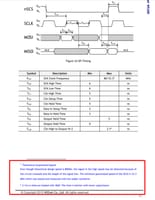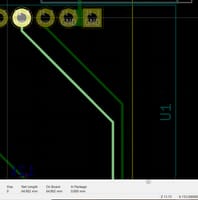FAQ
TL;DR: In microstrip crosstalk tools, L is the length where two traces run parallel, not net length or width; S is the spacing. “L is the length of the track where the two signals are parallel.” Example stat: SPI SCLK discussed at 80 MHz. [Elektroda, Anonymous, post #21683194]
Why it matters: Entering the correct L and S gives realistic near/far‑end crosstalk so you can keep SPI clocks clean on 2‑layer boards.
Quick-Facts
- L = parallel run length; S = edge‑to‑edge spacing. Use the longest parallel segment for worst‑case. [Elektroda, Anonymous, post #21683194]
- If spacing changes, split into segments and compute crosstalk for each, then use the worst. [Elektroda, Anonymous, post #21683195]
- Example from thread: S measured ≈ 0.5 mm; another segment S ≈ 0.7 mm with L ≈ 25 mm. [Elektroda, Anonymous, post #21683194]
- SPI layout tips: match CLK, MOSI, MISO lengths; route together; keep away from noisy signals. [Elektroda, Anonymous, post #21683188]
- SPI speeds noted: master SCLK up to 80 MHz; slave 20 MHz; stable operation ≥ 33 MHz mentioned for W5200. [Elektroda, Anonymous, post #21683184]
Quick Facts
- L = parallel run length; S = edge‑to‑edge spacing. Use the longest parallel segment for worst‑case. [Elektroda, Anonymous, post #21683194]
- If spacing changes, split into segments and compute crosstalk for each, then use the worst. [Elektroda, Anonymous, post #21683195]
- Example from thread: S measured ≈ 0.5 mm; another segment S ≈ 0.7 mm with L ≈ 25 mm. [Elektroda, Anonymous, post #21683194]
- SPI layout tips: match CLK, MOSI, MISO lengths; route together; keep away from noisy signals. [Elektroda, Anonymous, post #21683188]
- SPI speeds noted: master SCLK up to 80 MHz; slave 20 MHz; stable operation ≥ 33 MHz mentioned for W5200. [Elektroda, Anonymous, post #21683184]
What does “Length of Parallel Routes (L)” mean in crosstalk calculators?
L is the trace length over which two signals run side‑by‑side with the same spacing. It is not total net length. You measure only the portions that are parallel, because coupling occurs there. “L is the length of the track where the two signals are parallel.” [Elektroda, Anonymous, post #21683194]
Does L mean my track width or my entire net length?
Neither. Track width is unrelated here, and entire net length can overstate coupling. Use only the segment where your victim and aggressor run parallel with the same spacing. [Elektroda, Anonymous, post #21683194]
What does the spacing “S” parameter represent?
S is the edge‑to‑edge distance between the two traces in the parallel section. Measure S for each distinct parallel region you plan to analyze. [Elektroda, Anonymous, post #21683188]
How do I measure L and S on my layout? (3‑step)
- Highlight the two nets and mark where they run side‑by‑side.
- Measure edge‑to‑edge spacing S within each parallel region.
- Measure the length L of each region and analyze separately; take the worst case. [Elektroda, Anonymous, post #21683195]
If spacing changes along the route, how should I enter values?
Split the route into sections. For each section, use its own L and S to compute crosstalk. Compare results and design to the worst‑case section. [Elektroda, Anonymous, post #21683195]
Which nearby signals should I worry about for SPI SCLK?
Any trace that runs in parallel with SCLK is a potential aggressor or victim. The thread example highlights runs near GPIO13 and GPIO14 as relevant parallel sections to evaluate. [Elektroda, Anonymous, post #21683186]
What SPI speeds were discussed, and why do they matter for crosstalk?
The thread notes 80 MHz SCLK in master mode, 20 MHz in slave, and a 33 MHz stable‑operation note for W5200. Higher edge rates increase coupling risk, so layout discipline becomes critical. [Elektroda, Anonymous, post #21683184]
How should I route SPI to minimize crosstalk on a 2‑layer board?
Match CLK, MOSI, and MISO lengths, keep them short, and route them together to improve coupling symmetry. Keep them away from noisy clocks or switching nodes. [Elektroda, Anonymous, post #21683188]
Does crosstalk get worse with smaller spacing or longer parallel length?
Both increase coupling. The closer the traces and the longer they stay parallel, the higher the crosstalk. Prioritize increasing S and reducing L in critical areas. [Elektroda, Anonymous, post #21683194]
What number should I enter for L in the eeweb microstrip crosstalk tool?
Enter the length of the specific parallel section you are analyzing, not the whole net. If multiple sections exist, analyze each and use the worst result. [Elektroda, Anonymous, post #21683195]
Can L ever equal the entire net length?
Yes. If two traces maintain the same spacing for their whole run, then L equals the full net length for the calculation. This is an edge case that maximizes coupling. [Elektroda, Anonymous, post #21683194]
What is microstrip crosstalk in simple terms?
It is unwanted signal coupling between nearby traces that run in parallel on the same layer. The coupling mainly depends on spacing and the parallel length between aggressor and victim. [Elektroda, Anonymous, post #21683194]
How do I pick the worst‑case segment when several exist?
Choose the segment with the smallest spacing S and significant L. Compute each segment separately and design to the largest predicted crosstalk. [Elektroda, Anonymous, post #21683192]
Any quick numeric examples from the thread to guide inputs?
One section used S ≈ 0.5 mm; another had S ≈ 0.7 mm with L ≈ 25 mm. Start with the 0.5 mm segment as likely worst‑case, then compare. [Elektroda, Anonymous, post #21683194]
Why match SPI trace lengths at all?
Matched lengths reduce skew and jitter, which keeps sampling margins robust as frequency rises. “Ideally clk, mosi and miso tracks should be the same length.” [Elektroda, Anonymous, post #21683188]





